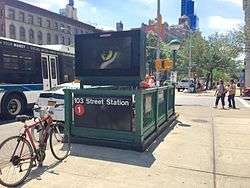103rd Street (IRT Broadway–Seventh Avenue Line)
103 Street | |||||||
|---|---|---|---|---|---|---|---|
|
| |||||||
|
Northbound platform | |||||||
| Station statistics | |||||||
| Address |
West 103rd Street & Broadway New York, NY 10025 | ||||||
| Borough | Manhattan | ||||||
| Locale | Upper West Side, Manhattan Valley | ||||||
| Coordinates | 40°47′58″N 73°58′05″W / 40.799419°N 73.968158°WCoordinates: 40°47′58″N 73°58′05″W / 40.799419°N 73.968158°W | ||||||
| Division | A (IRT) | ||||||
| Line | IRT Broadway–Seventh Avenue Line | ||||||
| Services |
1 | ||||||
| Transit connections |
| ||||||
| Structure | Underground | ||||||
| Platforms | 2 side platforms | ||||||
| Tracks | 3 (2 in regular service) | ||||||
| Other information | |||||||
| Opened | October 27, 1904[1] | ||||||
| Station code | 309[2] | ||||||
| Wireless service |
| ||||||
| Traffic | |||||||
| Passengers (2017) |
4,114,291[4] | ||||||
| Rank | 123 out of 425 | ||||||
| Station succession | |||||||
| Next north |
Cathedral Parkway–110th Street: 1 | ||||||
| Next south |
96th Street: 1 | ||||||
| |||||||
| |||||||
| |||||||
103rd Street is a local station on the IRT Broadway–Seventh Avenue Line of the New York City Subway. Located at the intersection of 103rd Street and Broadway on the Upper West Side of Manhattan, within Manhattan Valley, it is served by the 1 train at all times.
History
Operation of the first subway began on October 27, 1904, with the opening of the original 28 stations of the New York City Subway from City Hall to 145th Street on the West Side Branch including the 103rd Street station.[5][6]
In 1948, platforms on the IRT Broadway–Seventh Avenue Line from 103rd Street to 238th Street were lengthened to 514 feet to allow full ten-car express trains to platform. Previously the stations could only platform six car local trains. The platform extensions were opened in stages. On April 6, 1948, the stations from 103rd Street to Dyckman Street had their platform extensions opened, with the exception of the 125th Street, which had its extension opened on June 11, 1948.[7][8]
In 2002, it was announced that 103rd Street would be one of ten subway stations citywide, as well as one of five on the IRT Broadway–Seventh Avenue Line, to receive renovations.[9]
Station layout
| G | Street level | Exit/entrance |
| P Platform level |
Side platform, doors will open on the right | |
| Northbound local | ← | |
| Peak-direction express | → No regular service | |
| Southbound local | | |
| Side platform, doors will open on the right | ||
This station was part of the original subway, and has two side platforms and three tracks, the center one being an unused express track.[10] The southbound local track is known as BB1 and the northbound one is BB4; the BB designation is used for chaining purposes along the Broadway–Seventh Avenue Line from 96th Street to 242nd Street and not in everyday speech. Although it cannot be accessed at 103rd Street, the center track is designated as M.
This is the southernmost 3-track station on the line. South of the station, there are switches that connect the express track to either local track, with trains then being able to crossover to the rising express tracks from the IRT Lenox Avenue Line. Under 103rd Street, the dual express tracks serving the southern part of the line descend and curve to the east to form the IRT Lenox Avenue Line. They turn off of Broadway and onto 104th Street directly underneath this station. An emergency exit from the Lenox Avenue Line is located in the middle of the northbound platform.
Exits
In popular culture
The 103rd Street station was one of the settings in the William S. Burroughs book Junkie and was briefly featured in the film Black Swan.
References
- ↑ "Our Subway Open: 150,000 Try It". The New York Times. October 28, 1904. Retrieved 2012-04-02 – via nycsubway.org.
- ↑ "Station Developers' Information". Metropolitan Transportation Authority. Retrieved June 13, 2017.
- ↑ "NYC Subway Wireless – Active Stations". Transit Wireless Wifi. Retrieved May 18, 2016.
- ↑ "Facts and Figures: Annual Subway Ridership 2012–2017". Metropolitan Transportation Authority. July 12, 2018. Retrieved July 12, 2018.
- ↑ James Blaine Walker, Fifty Years of Rapid Transit, 1864-1917, published 1918, pp. 162-191
- ↑ "New York City subway opens - Oct 27, 1904". history.com. 1904-10-27. Retrieved 2015-10-25.
- ↑ Report for the three and one-half years ending June 30, 1949. New York City Board of Transportation. 1949.
- ↑ "More Long Platforms – Five Subway Stations on IRT to Accommodate 10-Car Trains". The New York Times. 1948-07-10. p. 8. ISSN 0362-4331. Retrieved 2016-03-27.
- ↑ "RENOVATION IS SET FOR 10 SUBWAY STATIONS". NY Daily News. June 11, 2002. Retrieved 2018-01-08.
- ↑ 103rd Street NYCSubway Retrieved 2009-06-24.
- 1 2 3 4 "MTA Neighborhood Maps: Upper West Side" (PDF). mta.info. Metropolitan Transportation Authority. 2015. Retrieved December 30, 2016.
Further reading
- Lee Stokey. Subway Ceramics : A History and Iconography. 1994. ISBN 978-0-9635486-1-0
External links

![]()
- nycsubway.org – IRT West Side Line: 103rd Street
- Station Reporter – 1 Train
- Forgotten NY – "Original 28 - NYC's First 28 Subway Stations". forgotten-ny.com. Archived from the original on 2006-12-24. Retrieved 2012-04-02.
- 103rd Street entrance from Google Maps Street View
- Platforms from Google Maps Street View



